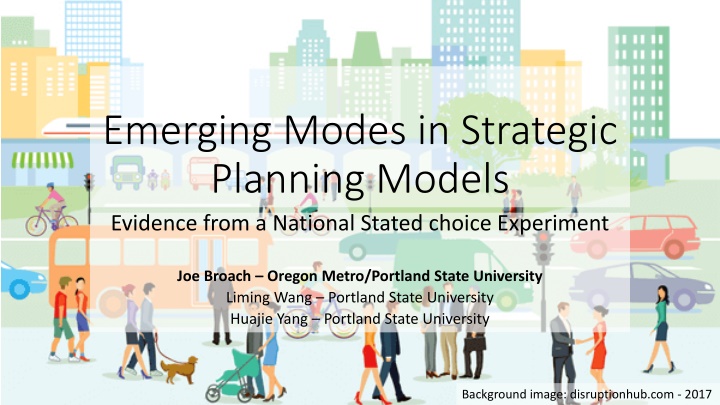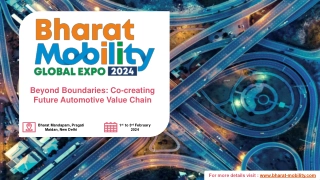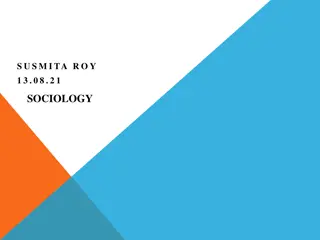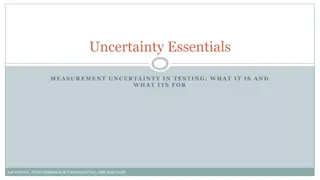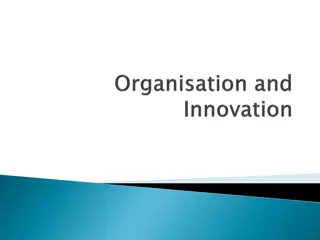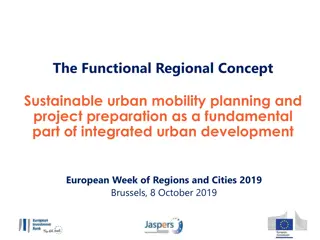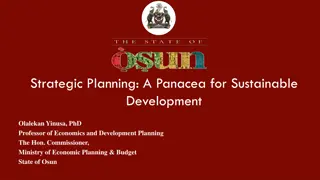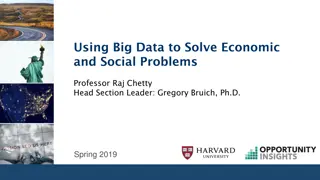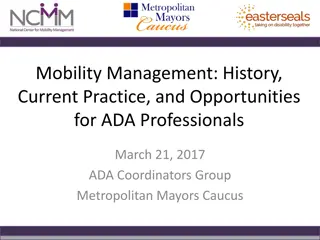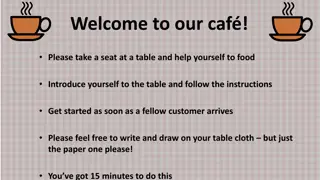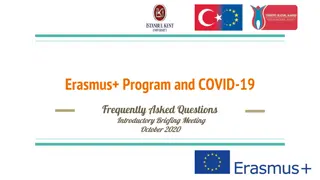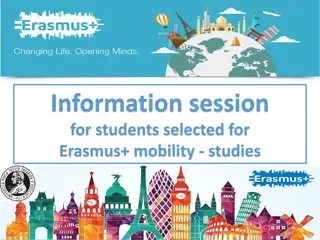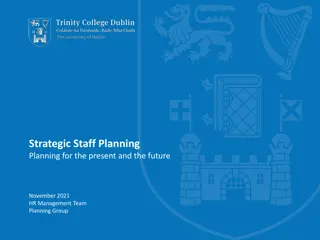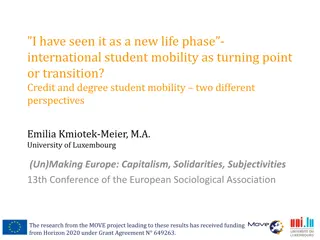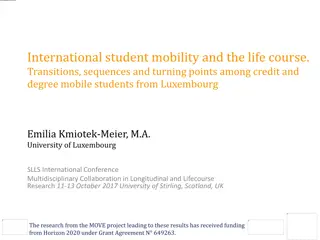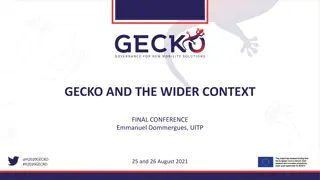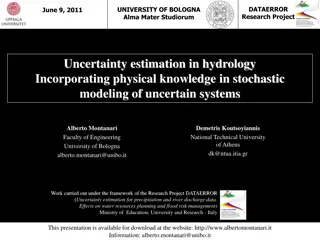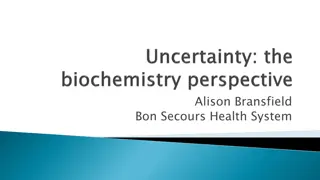Emerging Modes in Strategic Planning: Uncertainty in Mobility Options
Strategic planning models are evolving to accommodate emerging mobility options, but face challenges due to uncertainty in supply characteristics and demand responses. This study aims to identify supply attributes, explore individual demand responses, and integrate findings into a planning framework. The research involves a stated choice experiment, analysis of new options based on travel patterns, and the development of a multi-modal module for strategic planning models.
Download Presentation

Please find below an Image/Link to download the presentation.
The content on the website is provided AS IS for your information and personal use only. It may not be sold, licensed, or shared on other websites without obtaining consent from the author.If you encounter any issues during the download, it is possible that the publisher has removed the file from their server.
You are allowed to download the files provided on this website for personal or commercial use, subject to the condition that they are used lawfully. All files are the property of their respective owners.
The content on the website is provided AS IS for your information and personal use only. It may not be sold, licensed, or shared on other websites without obtaining consent from the author.
E N D
Presentation Transcript
Emerging Modes in Strategic Planning Models Evidence from a National Stated choice Experiment Joe Broach Oregon Metro/Portland State University Liming Wang Portland State University Huajie Yang Portland State University Background image: disruptionhub.com - 2017
Motivation Strategic Planning Models becoming more capable, widespread Only as good as their future inputs Large uncertainty around supply characteristics and demand responses to emerging mobility options Flickr user Ken C CC-BY-NC, 2007 Flickr user Andres Gomez CC-BY, 2017 Transitwire.com, 2018 Flickr user monsieur paradis CC-BY-NC, 2017
Key Objectives 1. Identify reasonable range of supply attributes for emerging modes 2. Explore individual demand response to new options based on current travel patterns 3. Incorporate results into RSPM/VisionEval framework
Timeline Stated choice survey (Summer 2018) Emerging modes review/survey design Initial Analysis Additional Analysis Phase 1: Develop multi-modal Module for RSPM RSPM Module Update 2016 2017 2018 2019
Emerging modes Emerging mode alternatives Self-driving (ride-hail) Non self- driving Shared ride Shared vehicle Shared vehicle Ride-hail Shared ride (e.g. UberPOOL, Lyft Line) Shared vehicle (e.g. UberX, Lyft) Public bike share Floating car share (e.g. Car2go)
Approach Supply characteristics Modes in wide operation (car/bike share, ride-hail): scan of market rates Self-driving options: literature review Demand response: stated choice survey National (Top 50 UZAs) Adaptive (trip attributes adjusted to RP trip & UAZ context via NHTS) Web-based Discrete choice models fitted
Survey implementation Qualtrics/Python smartphone option Top 50 UZAs (email + mTurk)
Supply characteristics Self-driving alternatives Non-self-driving alternatives Self-driving (shared ride) Ride-hail (shared ride) Attribute Self-driving Ride-hail Car Share Bike Share In-vehicle travel time (mins) Out of pocket cost ($) RP distance at assumed 10 mi/hr revealed driving time or NHTS-based estimate $0.80 - $1.50 /mi + $0.10 - 0.30/min + $2.00 - 4.00 [0.35, 0.40, 0.45, 0.50] /min + 1.00 $0.30 - $2.00 /mi 0.5x 0.8x Self-driving $ 0.5x 0.8x Ride-hail $ [1.00, 2.00, 3.00] /trip Walk time (mins) NHTS city- specific model estimate 0 0 10 Wait time (mins) 2 10 2 15 2 10 2 15 0
Selected preliminary findings Results from ~900 initial respondents presented here (~1000 additional available) ~1600 RP trips ~8000 SC scenarios What is likely demand potential of emerging modes? Directly from experiment Stated mode shift rates What do people prefer given cost/time diffs and mode prefs? From the model Mode bias in a vacuum What do people prefer all else equal? Residual mode bias What errors would we make by assuming no mode bias?
Stated mode shift rates Lowest among current private vehicle users (bike, drive, get a ride) ~25% of scenarios shift to emerging modes Higher among current public transit riders and those walking ~40-50% of scenarios shift to emerging modes Highest among those already using emerging or shared modes ~60-75% of scenarios shift to a different mode Most likely to shift: bike share, car/vanpool, non-shared ride-hail
Emerging mode bias (fixed cost + time) shared ride- hail:av shared ride- hail ridehail:av bikeshare carshare ridehail mode bias constant -1.25 -1.30 -2.04 -2.10 -2.19 -2.22
Prediction bias if mode-specific prefs ignored shared ride- hail:av shared ride- hail ride-hail:av bike share car share ride-hail Impact of omitting mode bias on predicted 0.30 0.26 0.25 0.20 probability 0.12 0.09
Integrating into strategic planning models Phase 1 produced a multi-modal choice module for RSPM (VETravelDemand) Results here are being tested in simulations and will be added to module as options Raises questions about how to forecast trends in technology attitudes/preferences when structural breaks (self-driving) occur
Preliminary Conclusions & Implications Emerging modes generally NOT preferred at this time, all else equal (technology skepticism?); will need to be considerably cheaper/faster than existing options Failure to incorporate mode-specific preferences in strategic planning models could lead to significant over-prediction of emerging modes studied Inertia varies by current travel mode, with personal vehicle (incl. bicycle) users most reluctant to shift in short-run (did not examine longer-term decisions) If self-driving technology declines in cost as much as theoretical research suggests, changes in urban travel patterns could be substantial and particularly challenging for bike share and public transit markets
Further resources https://nitc.trec.pdx.edu/research/project/881/ https://visioneval.org/ https://github.com/cities/VETravelDemand If you d like to see the web survey instrument: https://portlandstate.qualtrics.com/jfe/form/SV_2uwDJ3vPn7wc0iV?so urce=test
